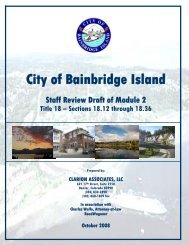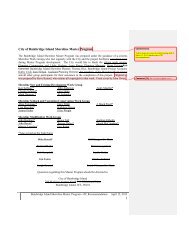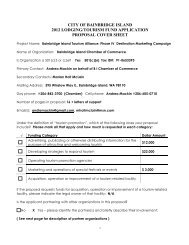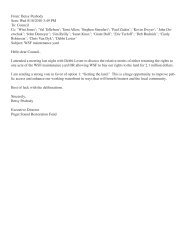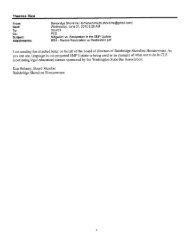- Page 1 and 2: City of Bainbridge Island Shoreline
- Page 3 and 4: 4.0 GENERAL (ISLAND-WIDE) POLICIES
- Page 5 and 6: 1.0 Introduction 1.1 Shoreline Mast
- Page 7 and 8: Master Program must be consistent w
- Page 9 and 10: To meet these challenges, the City
- Page 11 and 12: 1.3.2 Title Figure 1-2 Map of Bainb
- Page 13 and 14: provisions of this Master Program,
- Page 15: 1.5 Master Goal The City's shorelin
- Page 19 and 20: 7. To protect shoreline character a
- Page 21 and 22: c. Flood-prone areas. d. Areas with
- Page 23 and 24: 3.2.4.3 Management Policies 1. New
- Page 25 and 26: . Agriculture uses. c. Commercial u
- Page 27 and 28: 3.3.2.1 Purpose The purpose of the
- Page 29 and 30: 3.3.2.6 Type 4: Other areas Areas,
- Page 31 and 32: 1. For properties zoned single fami
- Page 33 and 34: Master Program Summary Matrices Tab
- Page 35 and 36: Table 4-1 Shoreline Use and Modific
- Page 37 and 38: Table 4-1 Shoreline Use and Modific
- Page 39 and 40: Table 4-1 Shoreline Use and Modific
- Page 41 and 42: Permitted and Conditional Uses Perm
- Page 43 and 44: Table 4-2 16.xx.xxx Dimensional Sta
- Page 45 and 46: Table 4-2 16.xx.xxx Dimensional Sta
- Page 47 and 48: Table 4-2 16.xx.xxx Dimensional Sta
- Page 49 and 50: Table 4-2 16.xx.xxx Dimensional Sta
- Page 51 and 52: Table 4-2 16.xx.xxx Dimensional Sta
- Page 53 and 54: Table 4-2 16.xx.xxx Dimensional Sta
- Page 55 and 56: Table 4-2 16.xx.xxx Dimensional Sta
- Page 57 and 58: Table 4-2 16.xx.xxx Dimensional Sta
- Page 59 and 60: 4.1 Environmental Quality and Conse
- Page 61 and 62: 4.1.2 Environmental Impacts 4.1.2.1
- Page 63 and 64: processes, if necessary; and iii. M
- Page 65 and 66: i. The depth may be reduced to five
- Page 67 and 68:
mitigation plan fail to be accompli
- Page 69 and 70:
4.1.3 Vegetation Management 4.1.3.1
- Page 71 and 72:
Vegetation Management goals and pol
- Page 73 and 74:
no net loss of ecological function,
- Page 75 and 76:
. Existing Primary Residential Stru
- Page 77 and 78:
Figure 4.1.b Bainbridge Island Shor
- Page 79 and 80:
4.1.3.8 Regulations - General Veget
- Page 81 and 82:
will result in an adverse effect to
- Page 83 and 84:
4.1.3.10 Vegetation Alteration Stan
- Page 85 and 86:
4.1.4 Land Modification 4.1.4.1 App
- Page 87 and 88:
4.1.5 Critical Areas 4.1.5.1 Applic
- Page 89 and 90:
3. Sand, gravel or other materials
- Page 91 and 92:
4. All alterations to the vegetatio
- Page 93 and 94:
4.1.6 Water Quality and Stormwater
- Page 95 and 96:
8. New residences or businesses on
- Page 97 and 98:
4.1.7 Flood Hazard 4.1.7.1 Applicab
- Page 99 and 100:
. They are consistent with BIMC 15.
- Page 101 and 102:
4.1.8 Shoreline Restoration and Enh
- Page 103 and 104:
the remainder of the City about the
- Page 105 and 106:
4.2 General Use 4.2.1 Nonconforming
- Page 107 and 108:
e continued subject to the provisio
- Page 109 and 110:
v. All other applicable standards a
- Page 111 and 112:
4.2.1.8 Regulations - Nonconforming
- Page 113 and 114:
that data, structures, and sites ha
- Page 115 and 116:
4.2.2.5 Submittal Requirements 1. W
- Page 117 and 118:
4.2.3.5 Regulations - Location and
- Page 119 and 120:
8. At each public or quasi-public l
- Page 121 and 122:
over maintenance of views from adja
- Page 123 and 124:
a. The public’s physical shorelin
- Page 125 and 126:
egulation (3)(a) above, signs may c
- Page 127 and 128:
f. Temporary directional signs to p
- Page 129 and 130:
a. New highways, arterials, seconda
- Page 131 and 132:
stormwater regulations of BIMC 15.2
- Page 133 and 134:
a. Located outside of the shoreline
- Page 135 and 136:
1. Sewage trunk lines, interceptors
- Page 137 and 138:
exceed fifty percent (50%) on Urban
- Page 139 and 140:
5.0 SPECIFIC SHORELINE USE AND DEVE
- Page 141 and 142:
. Where impacts to other existing a
- Page 143 and 144:
2. Aquacultural structures and acti
- Page 145 and 146:
5.2.7 Submittal Requirements 1. App
- Page 147 and 148:
5.3 Boating Facilities 5.3.1 Applic
- Page 149 and 150:
5.3.4 Regulations - Prohibited 1. B
- Page 151 and 152:
1. Proposals for marinas shall incl
- Page 153 and 154:
8. Live-aboard vessels must comply
- Page 155 and 156:
1. In addition to the general submi
- Page 157 and 158:
a. Water-oriented commercial use an
- Page 159 and 160:
a. Nature of the commercial activit
- Page 161 and 162:
proposals being reviewed as conditi
- Page 163 and 164:
1. Water-dependent industry shall b
- Page 165 and 166:
5.7 Mining 5.7.1 Applicability Mini
- Page 167 and 168:
areas. 9. Shoreline use of off-road
- Page 169 and 170:
permit review process, the City may
- Page 171 and 172:
5.8.7 Regulations - Golf Courses- D
- Page 173 and 174:
e. Control erosion and provide stor
- Page 175 and 176:
. Impervious Surfaces. No more than
- Page 177 and 178:
ensure usable access to the shoreli
- Page 179 and 180:
processes. 6. Avoid and reduce sign
- Page 181 and 182:
6.2 Shoreline Stabilization 6.2.1 P
- Page 183 and 184:
6. Preference is given to those typ
- Page 185 and 186:
New or Replacement Structural stabi
- Page 187 and 188:
6.2.8 Regulations - New or Replacem
- Page 189 and 190:
d. The new or expanded structure is
- Page 191 and 192:
6.3 Overwater Structures 6.3.1 Appl
- Page 193 and 194:
a. In Blakely Harbor new docks shal
- Page 195 and 196:
c. If the project includes the repl
- Page 197 and 198:
6.3.7.3.1 Float Stop Regulations 1.
- Page 199 and 200:
3. Bulk storage for gasoline, oil a
- Page 201 and 202:
a. At a minimum depth of 9 feet MLL
- Page 203 and 204:
6.4 Dredging and Dredge Material Di
- Page 205 and 206:
organic materials, or toxic substan
- Page 207 and 208:
3. Yearly status reports shall be p
- Page 209 and 210:
1. Landfill is allowed as Condition
- Page 211 and 212:
ADMINISTRATION (Moved to Title 2) 7
- Page 213 and 214:
Aquaculture, Incidental Small-scale
- Page 215 and 216:
Beach Nourishment - The process of
- Page 217 and 218:
Coastline - The line where terrestr
- Page 219 and 220:
in that community's history and are
- Page 221 and 222:
Ecology (Washington State Departmen
- Page 223 and 224:
an action's infeasibility, the revi
- Page 225 and 226:
Forest Practice - Any activity cond
- Page 227 and 228:
Height - The distance measured from
- Page 229 and 230:
does not involve the construction o
- Page 231 and 232:
v. Mitigation, enhancement: the man
- Page 233 and 234:
upland in respect to vegetation as
- Page 235 and 236:
ecognized species used for tribal c
- Page 237 and 238:
Salish Sea - Broadly defined as the
- Page 239 and 240:
shoreline master program for a coun
- Page 241 and 242:
other printed materials intended fo
- Page 243 and 244:
Tidal Water - Includes marine and e
- Page 245 and 246:
hydroelectric generating plants, gr
- Page 247 and 248:
Appendix A Shoreline Designation Ma
- Page 249 and 250:
8. “Educational or scientific act
- Page 251 and 252:
23. “Hydric soil” means soil wh
- Page 253 and 254:
34. “Reasonable alternative” me
- Page 255 and 256:
i. Lands defined as wetlands shall
- Page 257 and 258:
8. Hazard Tree Removal. Where a thr
- Page 259 and 260:
D. Public notice. Appropriate notic
- Page 261 and 262:
elating to wetlands. If the State a
- Page 263 and 264:
viii. Water control structures and
- Page 265 and 266:
1. Bainbridge Island is dependent u
- Page 267 and 268:
Activity Statute - Regulation - Gui
- Page 269 and 270:
a. Marine Critical Areas. Commercia
- Page 271 and 272:
Stream Category Water Quality Habit
- Page 273 and 274:
e recorded together with the land d
- Page 275 and 276:
shall meet the satisfaction of, and
- Page 277 and 278:
ii. Hazards Analysis. The hazards a
- Page 279 and 280:
d. Proposed buildings shall be cons
- Page 281 and 282:
4. The construction of public or pr
- Page 283 and 284:
2. Category II wetlands are difficu
- Page 285 and 286:
Wetland Characteristics function fo
- Page 287 and 288:
Wetland Characteristics Moderate le
- Page 289 and 290:
wetland buffer. The Director may ap
- Page 291 and 292:
13. Public Facility 14. Public Proj
- Page 293 and 294:
c. In order to implement the goals
- Page 295 and 296:
3. Compensation areas shall be dete
- Page 297 and 298:
such compensation. Construction of
- Page 299 and 300:
B. “Option B” - Mitigated Stand
- Page 301 and 302:
Appendix C Buffer Recommendation Me
- Page 303 and 304:
The City’s existing SMP utilizes
- Page 305 and 306:
jr /10-04851-000 buffer recommendat
- Page 307 and 308:
spawning beaches may require a larg
- Page 309 and 310:
following impacts, which would have
- Page 311 and 312:
200 FT Shoreline Jurisdiction Legen
- Page 313 and 314:
jr /10-04851-000 buffer recommendat
- Page 315 and 316:
Table 1. Suggested Range of Riparia
- Page 317 and 318:
References Bavins, M., D. Couchman,
- Page 319:
ATTACHMENT A Current Marine Shoreli
- Page 322 and 323:
Development Standards Upland Enviro
- Page 324 and 325:
land use. Table 1 provides a summar
- Page 326 and 327:
patterns or the chemical characteri
- Page 328 and 329:
Appendix D DRAFT Single Family Resi
- Page 330 and 331:
What is a typical bluff? A typical
- Page 332 and 333:
including all accessory development
- Page 334 and 335:
To assist you with planting areas o
- Page 336 and 337:
Also, in many instances, the footpr
- Page 338 and 339:
.For a single-use structure, the fl
- Page 340:
Bainbridge Island Shoreline Master



